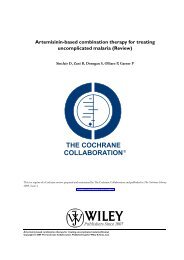Antiamoebic drugs for treating amoebic colitis - The Cochrane Library
Antiamoebic drugs for treating amoebic colitis - The Cochrane Library
Antiamoebic drugs for treating amoebic colitis - The Cochrane Library
Create successful ePaper yourself
Turn your PDF publications into a flip-book with our unique Google optimized e-Paper software.
Pamba 1990 (Continued)<br />
Inclusion criteria: children with clinical symptoms of intestinal amoebiasis with stool specimens positive <strong>for</strong> E.<br />
histolytica by direct smear and a concentration method (not specified)<br />
Exclusion criteria: pregnant women; known allergy to the <strong>drugs</strong>; those with co-existing extra-intestinal amoebiasis or<br />
other major diseases; treated with anti<strong>amoebic</strong> <strong>drugs</strong> in the 30 days be<strong>for</strong>e recruitment<br />
Interventions 1. Aminosidine (A): 500 mg twice daily orally <strong>for</strong> adults, 15 mg/kg body weight <strong>for</strong> children given orally <strong>for</strong> 5<br />
days<br />
2. Etophamide (E): 600 mg twice daily orally <strong>for</strong> adults,15 mg/kg body weight <strong>for</strong> children given orally <strong>for</strong> 5 days<br />
3. Nimorazole (N): 1 g twice daily orally <strong>for</strong> adults, 20 mg/kg body weight <strong>for</strong> children given orally <strong>for</strong> 5 days<br />
4. Combination of nimorazole and aminosidine (NA): same doses as above <strong>for</strong> 5 days<br />
5. Combination of nimorazole and etophamide (NE): same doses as above <strong>for</strong> 5 days<br />
6. Combination of etophamide and aminosidine (EA): same doses as above <strong>for</strong> 5 days<br />
Outcomes 1. Parasitological cure: disappearance of any <strong>for</strong>m of E. histolytica from stools or ulcer scrapings at the end of<br />
treatment<br />
2. Recurrence (relapse): reappearance of E. histolytica during follow up on days 15, 30, and 60 after initial<br />
disappearance; due to incomplete data on follow up; results could not be included in the meta-analysis<br />
3. Clinical cure: disappearance of all baseline symptoms at the end of treatment<br />
4. Adverse events: clinical adverse events monitored during treatment<br />
Not included in this review: cumulative daily clearance of E. histolytica from stools during treatment, at the end of<br />
treatment, and on days 15, 30, and 60 after start of treatment; evolution of mild and severe <strong>amoebic</strong> ulcers seen on<br />
rectosigmoidoscopy; and anatomical cure (healing of previous ulceration)<br />
Notes Location: 3 district hospitals of Kiambo, Machakos and Kilifi in Kenya, Africa<br />
Date: 1990 (date of publication only; actual study period not reported)<br />
Source of funding: Farmitalia Carlo Erba<br />
Panggabean 1980<br />
Methods Generation of allocation sequence: unclear<br />
Allocation concealment: unclear<br />
Blinding: reported as “double-blind”, but only care provider was blinded; blinding of participants and outcome<br />
assessors not described<br />
Inclusion of all randomized participants: 62.5% (25/40) 1 week after treatment, 42.5% (17/40) 2 weeks after treatment,<br />
27.5% (11/40) 3 weeks after treatment, and 15% (6/40) 4 weeks after treatment<br />
Participants Number: 40 enrolled; 25/40 (62.5%) analysed 1 week after treatment, 17/40 (42.5%) analysed 2 weeks after treatment,<br />
11/40 (27.5%) analysed 3 weeks after treatment, and 6/40 (15%) analysed 4 weeks after treatment<br />
Inclusion criteria: children with <strong>amoebic</strong> dysentery presenting with bloody stools and motile haematophagous trophozoites<br />
of E. histolytica in stools examined by direct smear method with eosin 2% stain<br />
Exclusion criteria: not stated<br />
Concomitant intestinal infection: 35 participants included in the analysis had concomitant intestinal helminthic<br />
infection and groups were comparable <strong>for</strong> numbers and type of concomitant intestinal helminthic infection (tinidazole<br />
group: Ascaris lumbricoides 10, Trichuris trichiura 26, Ancylostoma 2; ornidazole group: Ascaris lumbricoides 12,<br />
Trichuris trichiura 12, Ancylostoma 3)<br />
<strong>Anti<strong>amoebic</strong></strong> <strong>drugs</strong> <strong>for</strong> <strong>treating</strong> <strong>amoebic</strong> <strong>colitis</strong> (Review)<br />
Copyright © 2009 <strong>The</strong> <strong>Cochrane</strong> Collaboration. Published by John Wiley & Sons, Ltd.<br />
47








